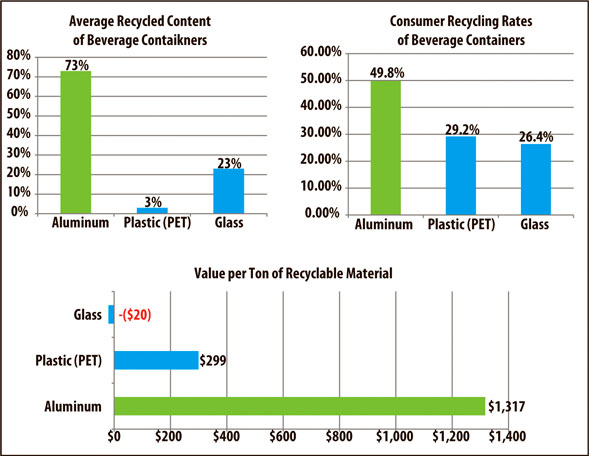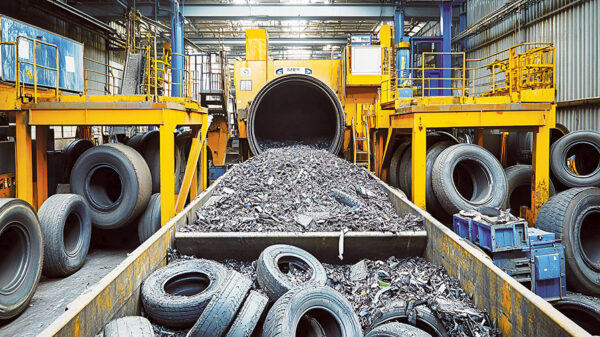A newly released report by the Aluminum Association and the Can Manufacturers Institute (CMI) shows that aluminum cans continue to outperform competitive packaging types on a number of key sustainability metrics.
 The new report – “The Aluminum Can Advantage: Key Sustainability Performance Indicators 2019” – finds that consumers recycle aluminum cans at nearly double the rate of glass or plastic bottles and that average recycled content for an aluminum can produced in the U.S. rose from 70 to 73 percent, compared to 23 percent for glass and 3 percent for plastic. In addition, the report found that the aluminum can scrap is dramatically more valuable than glass or plastic in the recycling bin. Because of this, aluminum effectively subsidizes the recycling of less valuable material in the recycling stream. “Can manufacturers take great pride in providing the most sustainable package in the world,” said Robert Budway, president & chief executive officer of CMI. “When consumers have finished enjoying their favorite beverages in aluminum cans, they should go the extra mile to recycle aluminum cans. Cans are the backbone of our country’s recycling system, and every can properly recycled makes a significant, positive impact in saving resources for future generations.”
The new report – “The Aluminum Can Advantage: Key Sustainability Performance Indicators 2019” – finds that consumers recycle aluminum cans at nearly double the rate of glass or plastic bottles and that average recycled content for an aluminum can produced in the U.S. rose from 70 to 73 percent, compared to 23 percent for glass and 3 percent for plastic. In addition, the report found that the aluminum can scrap is dramatically more valuable than glass or plastic in the recycling bin. Because of this, aluminum effectively subsidizes the recycling of less valuable material in the recycling stream. “Can manufacturers take great pride in providing the most sustainable package in the world,” said Robert Budway, president & chief executive officer of CMI. “When consumers have finished enjoying their favorite beverages in aluminum cans, they should go the extra mile to recycle aluminum cans. Cans are the backbone of our country’s recycling system, and every can properly recycled makes a significant, positive impact in saving resources for future generations.”
The new study tracks a number of different sustainability key performance indicators for the aluminum beverage can including industry recycling rate, consumer recycling rate, recycled content and value of material. Taken together, these indicators provide a holistic view of the sustainability performance of the can as a guide for consumers, customers, non-governmental organizations, policymakers and other stakeholders across the value chain.
Key findings in the 2019 report include:
•The industry recycling rate, which factors in used beverage container (UBC) imports and exports, remained basically steady in 2017 and 2018 at 63.3 and 63.6 percent, respectively. This exceeds the 20 year average industry recycling rate of 59.1 percent and is an indicator of the industry’s commitment to using recycled material in aluminum can production.
•The consumer recycling rate for aluminum beverage cans jumped nearly 5 points to 49.8 percent in 2018 from 45.1 percent in 2017. The 20 year average for the aluminum can recycling rate is 50.1 percent.
•The average recycled content of an aluminum can (last updated in 2014) rose from 70 to 73 percent, far exceeding rival packaging types such as glass and plastic.
•The aluminum can remains by far the most valuable package in the recycling bin, with a value per ton of $1,317/ton compared to $299/ton for plastic and a negative value of $20/ton for glass.
“For every 5 percent increase in consumer recycling of aluminum, approximately $100 million in aluminum value is saved from landfills,” Budway added. “It is no exaggeration to say that the modern recycling system could not work economically without the contributions of aluminum.”
Multiple independent studies have concluded that aluminum is the only beverage container type in the recycling bin that generates a net profit for municipal recycling programs. For example, a study of the “Blue Box” curbside program in Ontario, Canada, showed that aluminum cans brought in $290 per ton of material collected in 2018 (after costs) while glass and plastic cost the system money. Similarly, according to CalRecycle data, aluminum cans generate $831 per ton collected in California’s bottle deposit system (after costs) while plastic and glass cost the system $253 and $120 respectively per ton of material collected.
“The economic logic is simple – the more aluminum we can return back to the recycling stream, the healthier the overall system,” Wilk said.
Each year in the U.S. roughly 45 billion cans – more than $800 million worth of aluminum – end up in landfills, the equivalent of eleven 12-packs of cans for every person in the U.S. The aluminum can industry supports efforts to increase recycling through public education, advocacy for public policy to increase the quantity and quality of recovered aluminum and engagement with groups, including the Recycling Partnership, a multi-material nonprofit working with local municipalities to measurably improve residential curbside recycling programs and infrastructure.
Published in the October 2019 Edition






